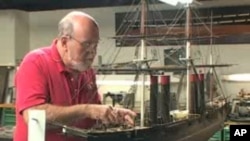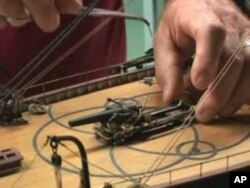For every U.S. Navy ship that sets sail, there is a model replica of it somewhere in the world.
Conservators with the U.S. Navy's Ship Model Program build, preserve and display scale models of ships in museums and facilities. The program dates to the 1880s. Since then, models of each new class of Navy ships have been handmade with excruciating attention to detail. There are now more than 2,500 models in the Navy's collection.
Conservator Colan Ratliff has been building a model of the USS Wampanoag - a famous US Navy ship from the American Civil War - for the past 24 years at the Naval Surface Warfare Center near Washington D.C.
"It was the fastest ship in the world and held that record for over 25 years before it was broken by the USS Columbia," he says. "Thousands of man-hours go into replicating every detail on the ship."
Ratliff is experimenting with new modeling techniques such as copper plating, which has always been a problem in the museum community since the copper plates fall off as time passes. The 5,000 miniscule copper plates Ratliff has applied are expected to stay put for more than a century.
Building, repairing and preparing ship models for display are the mission of Ratliff and his colleagues, Dana Wegner and Michael Condon. They've been at it for almost 30 years.
"We have to be a historian, understanding what parts need to go on to the ship, making sure the appropriate gun goes on the appropriate period of ship, the rigging is correct for that time period," says Ratliff. "There are so many little facets. We have to be as fine as a jeweler."
Dana Wegner is the team's curator. "We keep very few of them here. Our goal is to get as many of them out on display and to be seen by the public as possible."
While some models were assembled at the Naval Surface Warfare Center workshop, the older ones were mostly built by craftsmen at the shipyards when the ships were being built.
"We have two-and-a-half thousand models. The entire collection is valued at about a half-billion dollars," says Wegner. "Most are on display in the lobbies of buildings and museums. We support many museums worldwide. Here in Washington, D.C., the Navy Museum at the Washington Navy Yard has over 100 of our models."
Some of the creations, like one from 1892, are irreplaceable. A model of the USS Katahdin is one of a kind, say Wegner. "They only built one ship of this type."
With only three conservators and 2,500 models to oversee, the trio has to be all things to the models. Detailed records guide them in their work.
"Some of our models of course have been around well over 100 years," says Wegner. "We can track when they were built, how much they cost, where they have been in their lifetime, and repairs have been done to them over the years."
The three conservators are all 63 years old. Even though they have no immediate plans to retire, a young conservator has been added to the staff.
"I am trying to learn as much as I can before that day happens," says Brian Potter, 26. "So trying to learn everything that they know and also bring something that I know new to the table."








